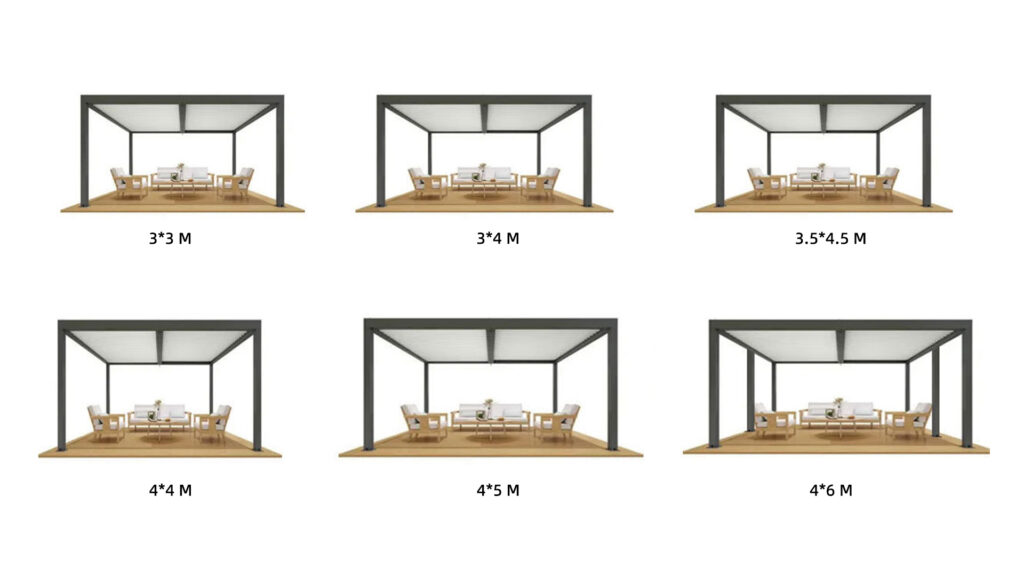Como escolher o tamanho certo da pérgola: o roteiro definitivo (2025)
Escolher uma pérgola é um passo emocionante para criar o quintal dos seus sonhos. No entanto, há uma decisão crucial que separa a sua visão da realidade: escolher o tamanho certo. Uma pérgola de tamanho incorreto pode atrapalhar a harmonia do seu espaço externo.muito pequeno e parece insignificante; muito grande e se torna opressor.
Seu roteiro para a confiança
Este guia é mais do que um conjunto de instruções; é um roteiro completo. Acompanharemos você por todo o processo, desde a compreensão da importância do tamanho até as etapas finais da escolha da marca e da compra. Seguindo este guia, você passará da incerteza para a confiança absoluta, garantindo que seu investimento se encaixe perfeitamente e aprimore sua casa e seu estilo de vida por muitos anos.
Por que obter o tamanho certo da pérgola é essencial
Antes de mergulharmos no "como", vamos estabelecer o "porquê". Errar no tamanho não é um erro pequeno; ele afeta três áreas principais:
Falha funcional
Uma pérgola muito pequena simplesmente não se adequa ao seu estilo de vida. Sua mesa de jantar para seis pessoas parecerá apertada, ou suas espreguiçadeiras não deixarão espaço para andar. Ela não cumpre seu propósito principal.
Desequilíbrio Estético
Uma pérgola é um elemento arquitetônico importante. Se a sua escala não for adequada à sua casa e quintal, pode parecer um erro visual, prejudicando a aparência da sua casa em vez de realçá-la.
Investimento desperdiçado
Uma pérgola mal dimensionada é um investimento que não traz todo o seu valor. Escolher o tamanho certo garante que cada centavo investido se traduza diretamente em um imóvel bonito, funcional e valioso.
Como adaptar o tamanho da pérgola ao seu estilo de vida (com exemplos reais)
As dimensões de uma pérgola não são apenas números; elas são o projeto para o seu estilo de vida futuro. Vamos além da fita métrica e falar sobre como esses tamanhos proporcionam a sensação e os momentos que eles criam.
Pequenas pérgolas (por exemplo, 10'x10', 10'x12') – The Private Escape
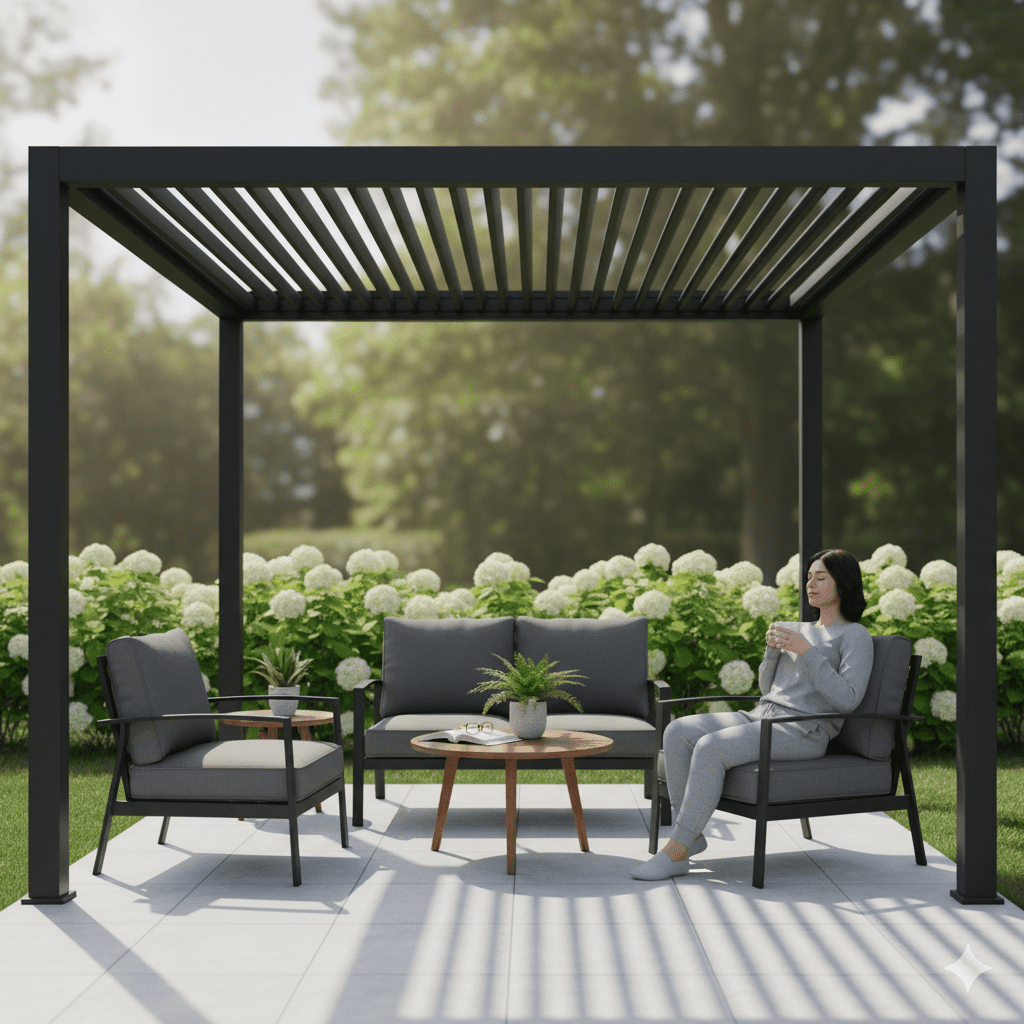
Imagine isso: É uma manhã tranquila. Você está em um espaço aconchegante de 3x3,6 m no seu pátio, aconchegado em uma poltrona confortável com seu primeiro café do dia. O mundo está agitado, mas este cantinho é todo seu. Este tamanho é perfeito para criar um cantinho intimista para duas a quatro pessoas. Não se trata de dar uma festa enorme; trata-se de criar um espaço dedicado à paz, a uma conversa tranquila ou a se perder em um bom livro.
Este tamanho é para você se: Você tem um quintal ou terraço menor ou quer criar um canto especial e isolado dentro de um jardim maior.
Pérgolas médias (por exemplo, 10'x14', 12'x16') – O coração da casa, ao ar livre
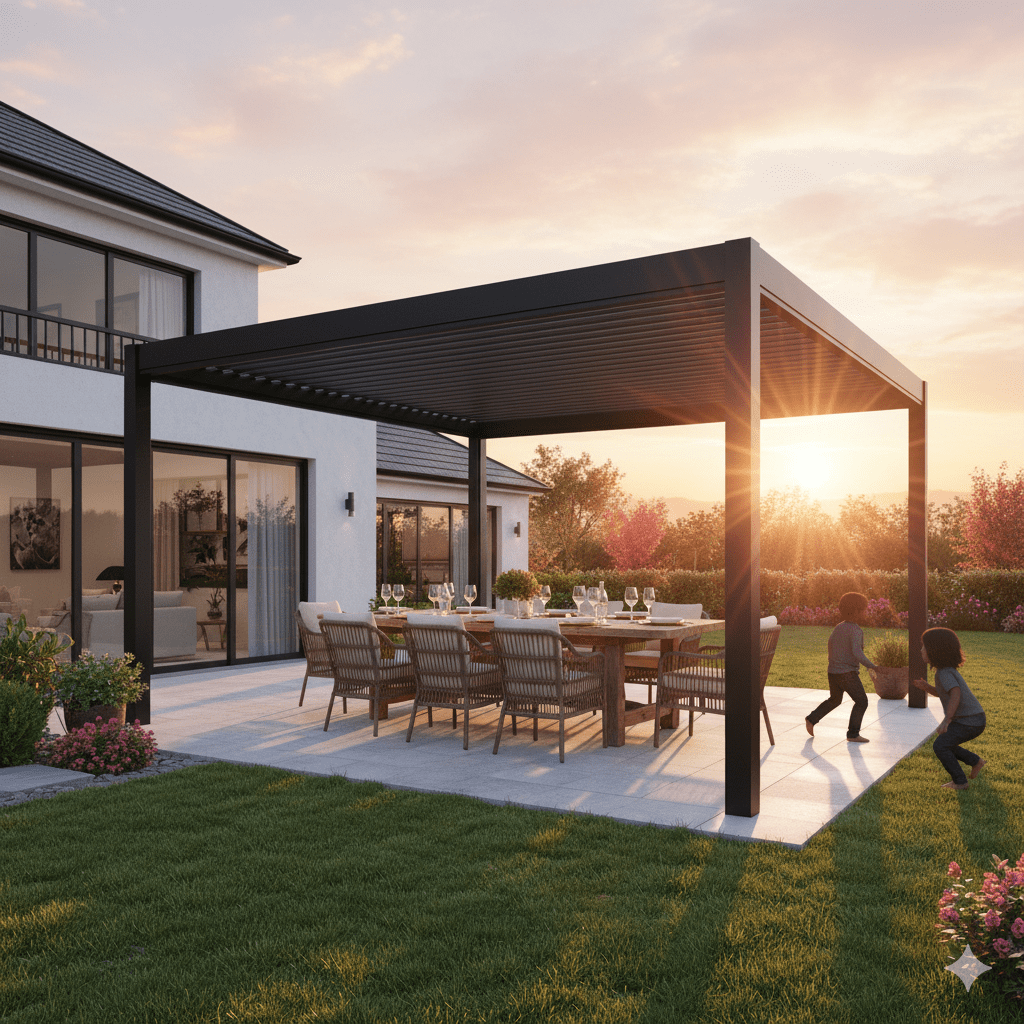
Imaginar: O sol está se pondo, e sua mesa de jantar para 8 pessoas cabe confortavelmente sob um teto de 3,6 x 4,8 m. Há espaço de sobra para puxar cadeiras e para as crianças correrem. É aqui que os jantares em família se transformam em longas noites de risadas, onde os churrascos de fim de semana com os amigos se tornam memórias queridas. Este tamanho não é apenas uma estrutura; é um convite. Ele diz: "Venha, tem espaço de sobra."
Este tamanho é para você se: Você adora receber visitas, tem uma família crescente ou quer um espaço versátil que possa funcionar tanto como uma sala de jantar ao ar livre quanto como uma área de estar confortável.
Pérgolas grandes (por exemplo, 12'x20' e mais) – O destino final
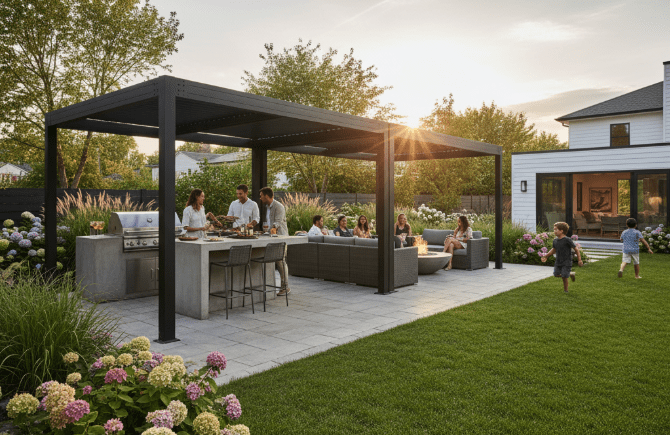
Imagine isso: Uma pérgola ampla de 3,6 x 6 metros cria mais do que apenas um espaço; ela cria um destino no seu próprio quintal. De um lado, uma cozinha externa totalmente equipada fervilha de atividade. Do outro, um luxuoso conjunto de sofás de frente para uma lareira aconchegante. Você não precisa escolher entre uma sala de jantar ou uma sala de estar — você tem as duas, perfeitamente conectadas. Este é o ápice da vida ao ar livre, um oásis em estilo resort construído para se destacar.
Este tamanho é para você se: Você tem um quintal grande, uma área de piscina para ancorar ou deseja criar um espaço multifuncional para entretenimento em grande escala.
O guia de 3 etapas para medir seu espaço perfeitamente
Esta é a fase mais crítica do seu projeto. O processo a seguir é profissional e testado em campo. A conclusão correta dessas três etapas garantirá um ajuste perfeito.
Antes de começar: reúna suas ferramentas
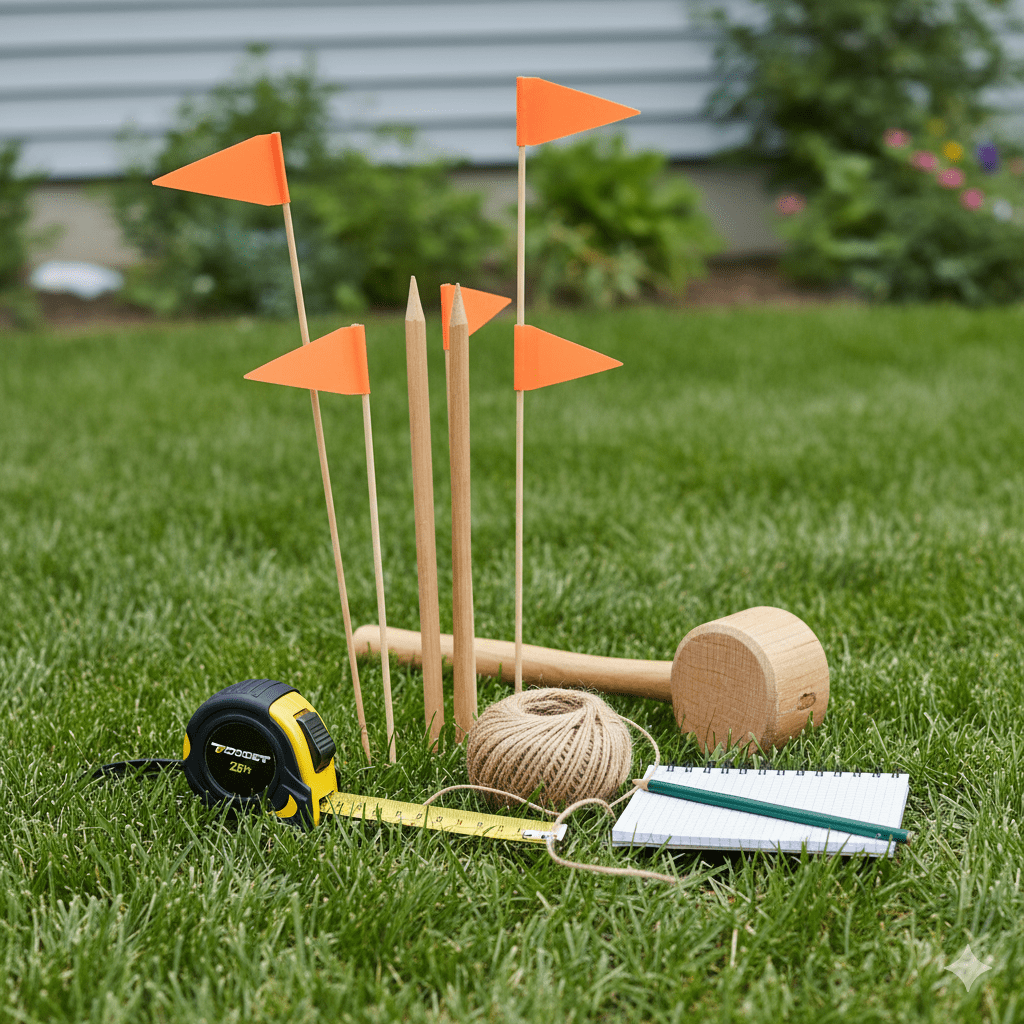
Um profissional trabalha com as ferramentas certas. Para esta tarefa, você precisará de:
- ✔Uma fita métrica de 25 pés (ou mais)
- ✔Quatro estacas de madeira ou bandeiras de plástico
- ✔Um martelo ou malho
- ✔Um novelo de barbante ou fio
- ✔Um bloco de notas e um lápis
Etapa 1: Marque sua “zona de ação”
Primeiro, definimos a pegada funcional. Ainda não se trata da pérgola; trata-se da sua vida dentro dela.
1.1 Limpe a área
Caminhe até o local proposto para a pérgola e retire todos os móveis, vasos ou brinquedos da área imediata para ter um espaço de trabalho limpo.
1.2 Estaqueie os cantos
Pegue suas quatro estacas e martele uma no chão onde você imagina o primeiro poste de canto. Marque o comprimento e a largura aproximados e coloque as outras três estacas. Não se preocupe com o alinhamento perfeito ainda; este é apenas um esboço visual.
1.3 Realizar o Teste de Estilo de Vida
Agora, coloque seus móveis principais (sua mesa de jantar para seis pessoas, suas duas poltronas) dentro da área delimitada. Contorne os móveis. Sente-se. Você consegue puxar uma cadeira sem que ela passe das estacas? Ajuste as estacas para dentro ou para fora em 15 cm ou 30 cm até que o espaço pareça confortável e sem aglomeração. Esta é a sua "Zona de Ação".
Etapa 2: Medir a pegada e o telhado
Agora traduzimos essa “sensação” em números concretos.
2.1 Criar uma grade
Passe o barbante ao redor da parte externa das quatro estacas, criando uma caixa estreita e reta no chão. Isso cria um limite preciso e visível para suas medições.
2.2 Medir a Pegada
Com sua fita métrica, meça o comprimento e a largura exatos desta caixa de barbante. Anote esses números imediatamente. Digamos que você tenha uma medida precisa de 3,25 m por 4 m. Esta é a sua área de implantação necessária de poste a poste.
2.3 Calcular o tamanho do telhado
Aqui está o cálculo profissional para o telhado. Adicione 30 a 60 cm a cada dimensão da sua área útil. Para a nossa área útil de 3,25 m x 4 m, um tamanho de telhado de 3,65 m x 4,55 m seria o ideal. Isso cria uma saliência funcional de 15 a 23 cm em cada lado, o que é fundamental para a estética e o escoamento adequado da água da chuva pelas venezianas.
Dica profissional: Se você estiver medindo sozinho, coloque uma chave de fenda no chão e prenda a ponta da fita métrica nela para obter uma leitura precisa e precisa em longas distâncias.
Etapa 3: Verifique se há obstruções verticais e ocultas
Um erro comum de amador é pensar apenas em duas dimensões. Agora, vamos escanear em 3D.
3.1 Verifique a folga vertical
Posicione-se onde você cravou uma estaca. Meça do chão até o ponto mais baixo de qualquer obstáculo acima da cabeça — geralmente, o beiral da sua casa, as calhas ou um galho de árvore grande. Você precisa de um espaço livre mínimo de 2,4 metros, mas de 2,7 a 3 metros é o ideal para evitar a sensação de aperto e permitir a instalação de um ventilador de teto.
3.2 Realizar uma varredura de obstáculos de 5 minutos
Estes são os cinco minutos mais importantes do projeto. Caminhe lentamente pelo perímetro e interior da sua caixa de barbante e procure por problemas ocultos:
- Nível do solo: Há sprinklers, grades de drenagem ou declives significativos na área?
- Subterrâneo: Você está perto de linhas de serviços públicos subterrâneas? (Nos EUA, é sempre aconselhável ligar para o 811 antes de cavar qualquer fundação).
- Acessibilidade: A porta da sua cozinha vai bater em um poste? Um poste vai bloquear o caminho da sua garagem até a porta dos fundos?
Escolhendo o tamanho da sua pérgola: 4 erros caros a evitar
Determinar o tamanho certo da sua pérgola é a parte mais crítica do processo de planejamento. Um simples erro de medição pode levar a uma compra que não se adapta ao seu espaço ou estilo de vida. Antes de finalizar qualquer cálculo, certifique-se de evitar estes quatro erros comuns (e custosos).
1. Entendendo mal o “tamanho oficial da pérgola” (telhado vs. pegada)
Este é o erro mais comum que os proprietários de imóveis cometem. O tamanho da pérgola listado na página do produto (por exemplo, 3,65 m x 4,85 m) refere-se às dimensões externas do telhado, incluindo qualquer saliência. Não se trata do espaço útil entre os postes. A área real entre os postes será menor, geralmente 30 cm ou mais de cada lado.
O erro: Supondo que uma pérgola de 12'x16' tenha uma área de estar de 12'x16'.
A consequência: Você acaba com um espaço funcional muito menor do que o previsto, e seus móveis parecem apertados. Sempre verifique as dimensões "poste a poste" nas especificações.
2. Esquecer que seu terreno não é perfeitamente plano
Seu quintal ou pátio pode parecer plano, mas quase certamente tem uma inclinação para drenagem. Uma inclinação aparentemente pequena de 7,5 a 10 cm em um vão de 3,6 metros pode criar problemas significativos de instalação.
O erro: Medição de um tamanho de pérgola padrão sem verificar o nível do solo.
A consequência: Você pode precisar de postes de comprimentos diferentes, o que exigirá cortes personalizados e poderá complicar a instalação. Use um nível longo para verificar a área antes de comprar.
3. Medindo apenas em 2D (ignorando altura e obstruções)
É fácil focar apenas no comprimento e na largura da área ocupada, mas uma pérgola é uma estrutura tridimensional.
O erro: Negligenciar a medição da altura vertical ou a verificação de obstáculos próximos.
A consequência: A pérgola chega, e você descobre que o telhado bloqueará uma janela do segundo andar, colidirá com um galho baixo de árvore ou que um poste impedirá a abertura total da porta dos fundos. Essa análise determina a altura máxima e o posicionamento viável para o tamanho de pérgola escolhido.
4. Medindo o espaço vazio, não o seu estilo de vida pretendido
Este é um erro estratégico. Não meça apenas o espaço máximo disponível no seu pátio e compre a maior pérgola que couber.
O erro: Escolha o tamanho da pérgola com base no espaço vazio, em vez da “zona de estar” funcional que você realmente precisa.
A consequência: Você pode acabar com uma pérgola enorme de 3,6 x 6 metros que parece vazia e impessoal porque seus móveis ocupam apenas um pequeno canto. O tamanho ideal da sua pérgola deve ser um cômodo aconchegante e bem definido, não um depósito vazio. Sempre faça o "teste de estilo de vida" com seus móveis primeiro.
Como escolher a marca certa de pérgola
Sabe, a marca que você escolhe determina a qualidade, a durabilidade e o aproveitamento a longo prazo do seu investimento. Aqui estão alguns fatores importantes a considerar:
1.
Natureza da marca
Vendas diretas da fábrica ou empresa de varejo, isso afetará seriamente o preço geral da pérgola.
2.
Qualidade do material
Procure marcas que especifiquem materiais de alta qualidade, como a liga de alumínio T6063-T5, conhecida por sua resistência e corrosão.
3.
Garantia
Uma garantia longa e abrangente é um indicador direto da confiança de uma empresa em seu produto.
4.
Avaliações e fotos de clientes
Procure avaliações que falem sobre a facilidade de instalação e o desempenho do produto ao longo do tempo.
5.
Design e recursos
A marca oferece os recursos modernos que você deseja, como um sistema de calhas integrado ou controles inteligentes?
Para saber mais sobre as principais marcas e nosso processo de seleção em 7 etapas, leia nossos guias completos:
Como escolher uma marca de pérgola → Melhores marcas de pérgolas de alumínio dos EUA →
Conclusão
Escolher o tamanho certo de pérgola não se resume apenas a medidas; trata-se de tomar uma decisão segura que moldará sua vida ao ar livre por muitos anos. Seguindo este guia — desde a compreensão das suas necessidades de estilo de vida até a medição meticulosa do seu espaço e a seleção da marca ideal — você transformou uma tarefa complexa em um processo estratégico e eficiente. Agora você está totalmente preparado para comprar a pérgola perfeita, sabendo que ela não só se encaixará no seu espaço, como também se adaptará perfeitamente à sua vida.
Perguntas frequentes
Meu pátio ou quintal tem uma leve inclinação. Como isso afeta as medidas da minha pérgola?
A medida da área de cobertura (comprimento e largura) não muda. No entanto, a inclinação é fundamental para determinar o comprimento correto do poste. Você deve medir a altura vertical em cada um dos quatro cantos demarcados. Um instalador profissional normalmente apara os postes no local para garantir que o telhado da pérgola esteja perfeitamente nivelado, mesmo que o solo abaixo dele não esteja. Muitos kits "faça você mesmo" também oferecem bases de poste ajustáveis para lidar com inclinações de alguns centímetros.
E se um obstáculo permanente, como um aparelho de ar condicionado ou um poço de janela, estiver exatamente onde um poste precisa ficar?
Não ignore. A solução mais comum é ajustar ligeiramente toda a área planejada. Muitas vezes, mudar todo o layout em apenas 6 a 12 polegadas em uma direção pode superar o obstáculo sem afetar significativamente o seu projeto. Se o obstáculo não puder ser evitado com o deslocamento, você deve consultar um profissional para discutir soluções personalizadas de fundação ou estrutura antes de comprar seu kit.
Meu pátio não é um retângulo perfeito. Como escolho a melhor posição para ele?
Concentre-se na sua área de estar, não no formato do pátio. Primeiro, organize seus móveis principais (mesa de jantar, sofá) no local mais funcional e desejável. Deixe que essa disposição dos móveis crie um retângulo virtual. O propósito da sua pérgola é cobrir essa área funcional. É perfeitamente aceitável — e geralmente fica melhor — se a pérgola cobrir a parte principal do seu pátio, deixando as áreas de formato irregular abertas.
A que distância da minha casa posso instalar uma pérgola independente?
Você precisa considerar duas coisas: códigos de construção e manutenção prática. Embora os códigos locais variem, uma regra geral segura é deixar pelo menos 15 cm de espaço entre a saliência do telhado da pérgola e os beirais ou calhas da sua casa. Isso evita que a água fique presa, permite a circulação de ar e oferece espaço suficiente para limpar janelas ou realizar manutenção no revestimento sem que a pérgola atrapalhe.
A medida da área de cobertura (comprimento e largura) não muda. No entanto, a inclinação é fundamental para determinar o comprimento correto do poste. Você deve medir a altura vertical em cada um dos quatro cantos demarcados. Um instalador profissional normalmente apara os postes no local para garantir que o telhado da pérgola esteja perfeitamente nivelado, mesmo que o solo abaixo dele não esteja. Muitos kits "faça você mesmo" também oferecem bases de poste ajustáveis para lidar com inclinações de alguns centímetros.
Não ignore. A solução mais comum é ajustar ligeiramente toda a área planejada. Muitas vezes, mudar todo o layout em apenas 6 a 12 polegadas em uma direção pode superar o obstáculo sem afetar significativamente o seu projeto. Se o obstáculo não puder ser evitado com o deslocamento, você deve consultar um profissional para discutir soluções personalizadas de fundação ou estrutura antes de comprar seu kit.
Concentre-se na sua área de estar, não no formato do pátio. Primeiro, organize seus móveis principais (mesa de jantar, sofá) no local mais funcional e desejável. Deixe que essa disposição dos móveis crie um retângulo virtual. O propósito da sua pérgola é cobrir essa área funcional. É perfeitamente aceitável — e geralmente fica melhor — se a pérgola cobrir a parte principal do seu pátio, deixando as áreas de formato irregular abertas.
Você precisa considerar duas coisas: códigos de construção e manutenção prática. Embora os códigos locais variem, uma regra geral segura é deixar pelo menos 15 cm de espaço entre a saliência do telhado da pérgola e os beirais ou calhas da sua casa. Isso evita que a água fique presa, permite a circulação de ar e oferece espaço suficiente para limpar janelas ou realizar manutenção no revestimento sem que a pérgola atrapalhe.

